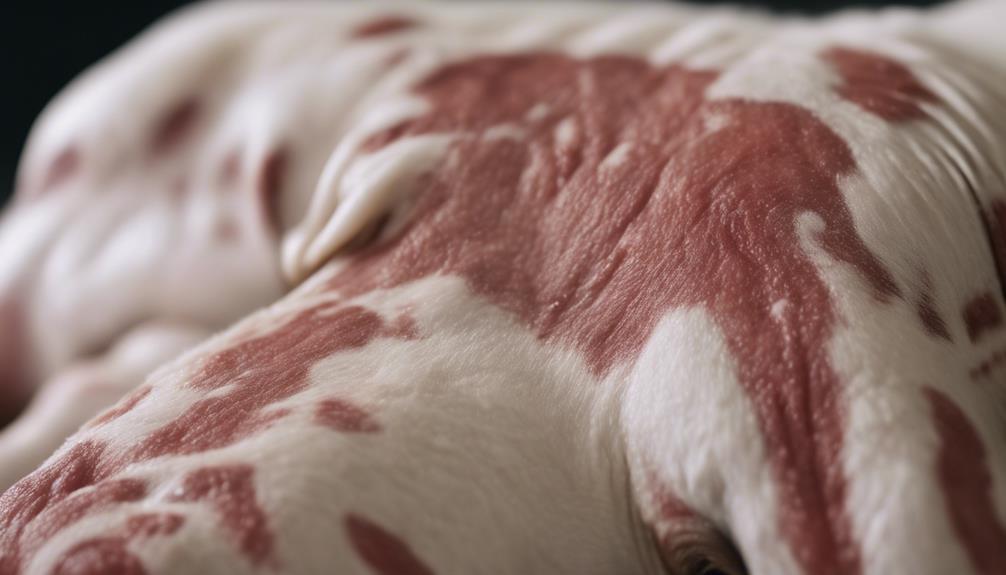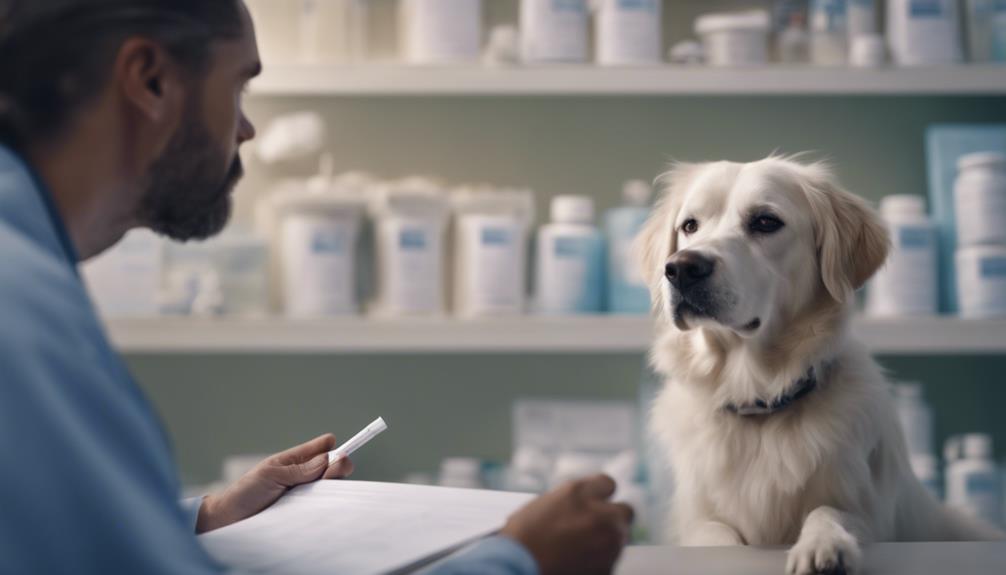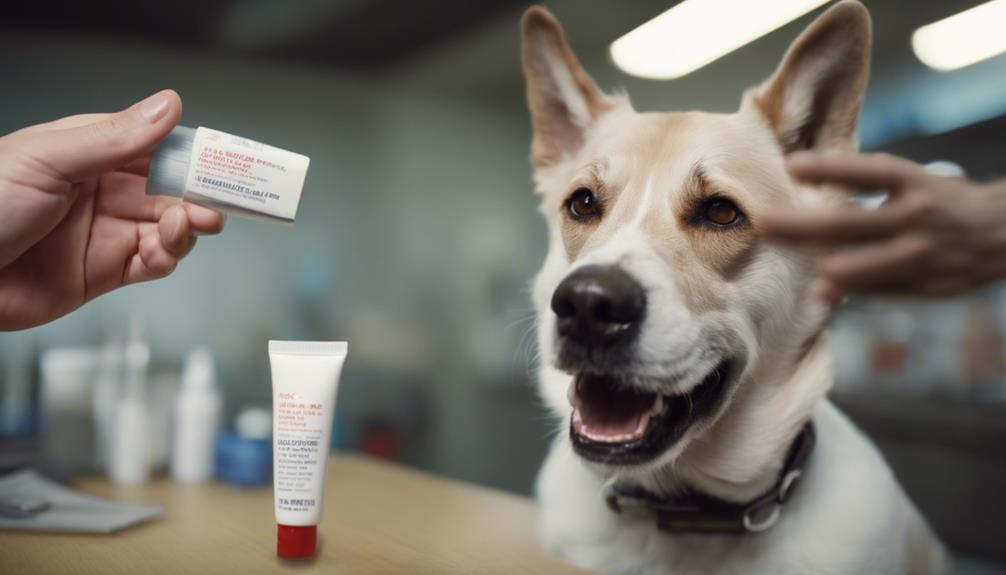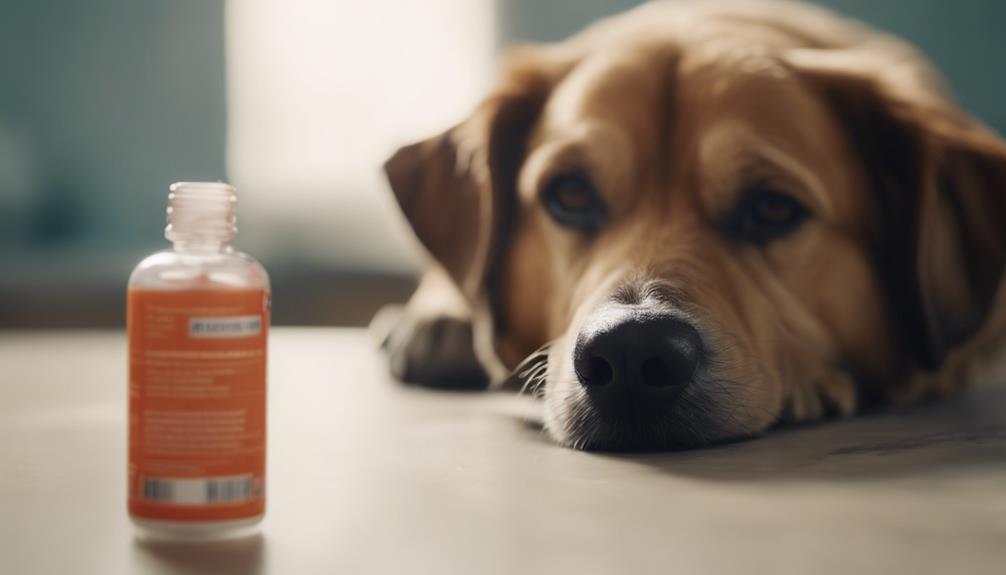When faced with the decision of whether to apply hydrocortisone on your dog, caution and prudence are paramount. The potential benefits of using this medication to alleviate your pet's discomfort may seem enticing, but the complexities surrounding its application require careful consideration.
Before taking any steps, it is crucial to understand the implications, nuances, and best practices involved in using hydrocortisone on dogs. By exploring the intricacies of this topic further, you will gain valuable insights that could influence your approach to managing your dog's health and well-being.
Key Takeaways
- Hydrocortisone can be used on dogs to reduce inflammation and itching.
- Apply cream once or twice daily to affected areas, avoiding open wounds.
- Consult a vet before use on pregnant or ill dogs.
- Prevent licking by using an Elizabethan collar and wash hands after application.
Benefits of Using Hydrocortisone on Dogs
When addressing skin irritations and inflammatory conditions in dogs, utilizing hydrocortisone can provide effective relief and aid in reducing discomfort efficiently.
Hydrocortisone, a steroid medication, works by reducing inflammation and itching, making it a valuable treatment for various skin issues in dogs. Available in cream and spray forms for topical application, it can swiftly decrease skin inflammation, typically within 30 minutes, and alleviate itching within one to two hours.
While hydrocortisone is generally safe for dogs, consulting a veterinarian before use is advisable, especially for pregnant or ill dogs. Opting for creams over sprays or gels with alcohol content is recommended, and preventing licking post-application can enhance its effectiveness in providing relief for minor irritations, skin allergies, hot spots, and other inflammatory conditions.
Types of Hydrocortisone for Dogs
Utilizing hydrocortisone for dogs comes with the consideration of different types suited for various applications and conditions, ensuring effective relief and management of skin-related issues. When choosing a hydrocortisone product for your dog, you may encounter the following options:
- Cream: Ideal for localized skin irritations and allergic reactions.
- Spray: Convenient for larger affected areas and hot spots.
- Ointment: Thicker consistency for prolonged skin contact and moisture retention.
Selecting the appropriate type of hydrocortisone based on your dog's condition can enhance the effectiveness of treatment while minimizing potential side effects.
How Hydrocortisone Works on Dogs

Hydrocortisone functions by reducing inflammation in dogs, providing relief for various skin-related issues. This steroid medication, available in cream and spray forms for skin application, can decrease skin inflammation within 30 minutes.
While hydrocortisone is effective in stopping itching within one to two hours, it's essential to note that steroids can slow healing and suppress the immune system. Therefore, caution is advised when using hydrocortisone on dogs, especially pregnant or ill ones. Opting for cream over sprays or gels with alcohol is preferable.
Additionally, consulting a veterinarian before use is recommended to ensure the safety and efficacy of hydrocortisone for your pet's specific condition.
Safety Guidelines for Applying Hydrocortisone
For safe and effective application of hydrocortisone on dogs, adherence to specific guidelines is crucial.
When applying hydrocortisone cream to your dog, consider the following safety guidelines:
- Apply a thin layer of the cream once or twice daily to the affected areas.
- Refrain from using the cream on open wounds to prevent potential complications.
- Remember to wash your hands after application to avoid any unintentional contact with your skin or mucous membranes.
Common Skin Issues Treated With Hydrocortisone

When considering the application of hydrocortisone cream on dogs, it is essential to understand the common skin issues that can be effectively treated with this medication. Hydrocortisone is commonly used to soothe minor irritations like bug bites and rashes in dogs.
It is also recommended for treating skin allergies, inflammatory skin diseases, and infections such as hot spots. Additionally, hydrocortisone can aid in decreasing inflammation in severe ear infections. Veterinarians often suggest hydrocortisone for various skin problems due to its anti-inflammatory properties.
Proper application and consultation with a vet are crucial to ensure the safe and effective use of hydrocortisone in addressing these common skin issues in dogs.
Potential Side Effects of Hydrocortisone on Dogs
Side effects from the use of hydrocortisone on dogs may include potential adverse reactions that pet owners should be aware of. These can vary depending on the individual dog and the dosage used.
Some common side effects to watch out for include:
- Thinning of the skin
- Delayed wound healing
- Increased thirst and urination
Monitoring your dog for any of these signs is crucial when using hydrocortisone to ensure their well-being. If you notice any concerning symptoms, it's essential to consult a veterinarian promptly to address any potential issues.
When to Consult a Vet Before Use

Considering the individual health status and specific needs of your canine companion, seeking guidance from a qualified veterinarian before applying hydrocortisone on your dog is strongly recommended. Veterinarians can provide tailored advice based on your dog's medical history, potential allergies, and any ongoing treatments. This is particularly crucial if your dog is pregnant, nursing, or has existing health conditions that may interact with the medication.
Consulting a vet can ensure that the correct dosage and application method are used, minimizing the risk of adverse reactions or complications. Your vet can also recommend alternative treatments or additional precautions to take while using hydrocortisone, ensuring the safety and well-being of your furry friend.
Tips for Applying Hydrocortisone on Dogs
Applying hydrocortisone on dogs requires careful attention to proper technique and dosage to ensure effective treatment and minimize potential risks. When applying hydrocortisone cream on your dog, consider the following tips:
- Gently cleanse the affected area before application to remove any dirt or debris.
- Use a small amount of hydrocortisone cream and rub it in thoroughly to ensure even coverage.
- Monitor your dog for any signs of irritation or allergic reactions after applying the cream.
Precautions for Using Hydrocortisone Cream

When using hydrocortisone cream on dogs, it is essential to be mindful of specific precautions to ensure the safe and effective application of this medication.
Firstly, consult a veterinarian before using hydrocortisone on pregnant or ill dogs to prevent any potential complications.
Opt for cream formulations over sprays or gels containing alcohol, as these can be harsh on the skin.
Avoid applying the cream directly on itchy scabs to prevent further irritation.
Additionally, wash your hands thoroughly after applying the cream to avoid any accidental ingestion.
It's crucial to follow these precautions to promote the well-being of your dog and maximize the benefits of hydrocortisone treatment.
Managing Licking Behavior After Application
After applying hydrocortisone cream on your dog, managing licking behavior is crucial to prevent potential ingestion issues and ensure the medication's effectiveness.
To prevent excessive licking, consider the following:
- Elizabethan Collar: This collar helps prevent licking or chewing on the treated area.
- Supervision: Keep a close eye on your dog to discourage licking behavior.
- Distractions: Provide engaging toys or activities to divert your dog's attention away from licking.
Risks of Hydrocortisone Ingestion by Dogs

To ensure the safety of your dog, understanding the potential risks associated with the ingestion of hydrocortisone is essential, especially following its application to the skin.
Ingestion of hydrocortisone by dogs can lead to various adverse effects. One significant risk is related to the suppression of the immune system, which can make the dog more susceptible to infections.
Additionally, ingestion of hydrocortisone may cause symptoms such as increased thirst and urination, gastrointestinal issues like vomiting and diarrhea, lethargy, and even more severe complications in some cases.
It is crucial to seek immediate veterinary assistance if you suspect your dog has ingested hydrocortisone to prevent any further harm.
Alternatives to Hydrocortisone for Dog Skin Care
In exploring alternatives to hydrocortisone for dog skin care, veterinarians often recommend considering non-steroidal options that prioritize gentle yet effective treatment methods. Some alternatives to hydrocortisone for managing dog skin issues include:
- Aloe vera gel: Known for its soothing properties, aloe vera can help alleviate skin irritation and promote healing.
- Coconut oil: With its natural antibacterial and anti-inflammatory properties, coconut oil can assist in moisturizing and calming the skin.
- Oatmeal baths: Oatmeal can provide relief for itchy skin and help in reducing inflammation, making it a popular choice for soothing various skin conditions in dogs.
Conclusion
In conclusion, the use of hydrocortisone on dogs can be beneficial for treating various skin conditions, but it is essential to follow safety guidelines and consult with a veterinarian before application.
Understanding the types of hydrocortisone available, how it works, and potential risks associated with ingestion is crucial for responsible pet care.
By adhering to proper precautions and exploring alternative options, pet owners can effectively address their dog's skin issues while prioritizing their health and well-being.




